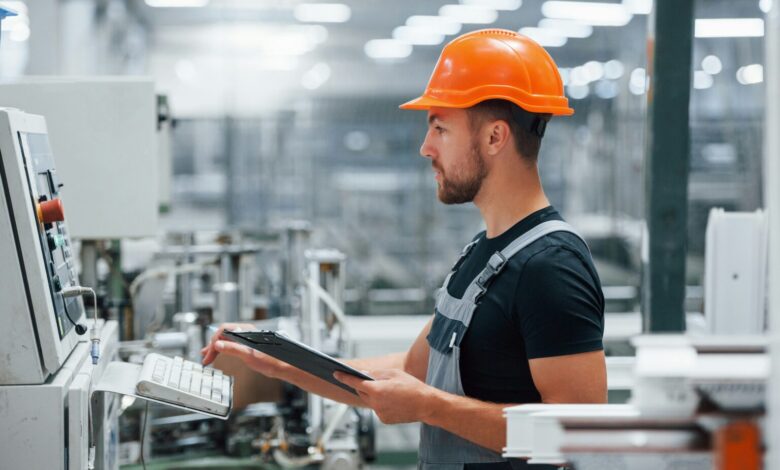
The manufacturing industry has reached a critical tipping point in operations. Sustainability and productivity are now considered to be make-or-break factors, whilst those who fall behind in performance and output risk facing increased scrutiny, reduced investment, and a decline in market confidence. Various economic, geopolitical, and social factors are also at play, hindering manufacturers’ ability to maximise the potential of their production lines.
Supply chain disruptions, rising costs, and skilled labour shortages are also listed among the industry’s most pressing challenges. Also consider the increasing number of regulations, and manufacturers face the perfect storm. To remain competitive, the sector as a collective is seeking smarter solutions, and putting optimisation at the top of the business agenda.
Manufacturing’s sustainability mission
Over the past decade, sustainability has shifted from a niche trend to a marker of success to the everyday expected. Today, sustainable manufacturing means balancing profitability with a corporate responsibility to look after people and the environment. The cynics amongst us may argue that the environmental push has largely been driven as a result of regulation, most notably in the UK the government’s net zero emissions target for 2050, but there is no doubt that consumer buying habits have also increasingly affected the landscape:
- Deloitte’s 2024 Sustainable Consumer survey found the most valued sustainable and ethical consumer practices are producing sustainable packaging and products, and reducing waste in manufacturing processes.
- McKinsey & Company has shown that products with sustainability-related claims on packaging experience higher sales growth (compared to those without such claims).
- PwC reports that some consumers are willing to pay a 9.7% premium for sustainably produced or sourced goods.
Manufacturers that prioritise and promote sustainability success could well increase profit margins and competitiveness, if they can also stay on top of increasingly stringent environmental regulations. But to really reap the rewards and see a benefit to the business, they must also minimise the negative environmental outcomes (waste), economic, and social impacts of production. Crucially, manufacturers need to optimise efficiency, drive innovation, and create long-term economic value without compromising sustainability.
Inefficiencies are hindering manufacturing productivity
Manufacturing inefficiencies – often the result of minor events cumulatively affecting productivity, such as downtime, breakdowns, or minor stops – are costing UK businesses significantly. For example, IDS-INDATA reports that UK and European manufacturers could indeed lose more than £80 billion due to downtime in 2025.
Overall Equipment Effectiveness (OEE), which represents the percentage of manufacturing time that is 100% productive, is also a key indicator of efficiency gaps in production lines. For instance, a recent Lineview global benchmark report found that the average OEE across six major types of food and beverage production lines is 51%, indicating significant equipment underperformance, and inefficient use, throughout production. These figures are also somewhat due to the growing diversity and complexity of food and beverage production which is significantly affecting operational costs and environmental efforts.
Accelerated digital transformation however is helping the industry adapt to shifting market demands to reduce hidden inefficiencies – keeping sustainability goals as the leading objective. Manufacturing intelligence, facilitated by artificial intelligence (AI), has become a key enabler of agile and productive production lines, helping manufacturers reduce waste and save costs.
Optimising production with data and AI
Access to live and business critical data straight from the factory floor will continue to help manufacturers optimise their processes and production lines if they are capturing it accurately, and understanding the analysis correctly. Manufacturers certainly aren’t short on production data – but the reality is that factory teams need improved knowledge of what the production lines are recording, and understanding how they can interpret real-time analytics to help them identify and, more importantly, remediate issues before they otherwise disrupt operations.
Manufacturing intelligence and AI is unlocking opportunities that would otherwise get lost in the noise. AI-powered data collection and analysis are helping manufacturers to embrace strategic decision making, such as locating additional capacity in existing production lines or pro-actively managing repair and maintenance schedules to avoid unplanned downtime. With access to live and historical data, manufacturers can conduct root cause analysis and predictive analysis that help factory workers at all levels understand what is happening in their production lines and why – even when comparing the data across multiple sites and geographies.
Unearthing such hidden inefficiencies and production risks shifts the manufacturing process from reactive to predictive, enabling timely interventions and improving production planning and reporting. This is especially crucial for continuous-flow manufacturing operations, where manufacturers depend on tightly integrated lines with sequential, interdependent processes.
Advanced data insights is already optimising factories around the world. For example, one of the world’s largest beverage manufacturers increased OEE by 20% in 24 months, where a single percentage point improvement translates to millions in additional revenue.
By achieving increased capacity in existing lines, manufacturers can drive additional revenue and, critically, delay the need for investment in new product lines. Of course this outcome – do more with less – helps to further steer sustainability efforts by reducing energy usage and waste, and lowering carbon emissions.
Embracing the AI opportunity
Data and intelligent analysis provide a single source of operational truth across manufacturing facilities that drives OEE and overall production efficiency, empowering teams to make faster and better informed decisions. These gains have the potential to pay dividends with an uptick in sustainability metrics, by reducing waste whilst using energy and water more responsibly throughout manufacturing processes. A real world example, for context, would be if a business has 50 production lines running at 50% OEE, increasing that OEE by just 10% would create an additional five production lines of capacity – for free. This delivers both a material cost saving to the business, and positively impacts sustainability metrics.
Establishing a strong data foundation is laying the groundwork for AI-ready capabilities which will become increasingly critical as industry leaders look to capitalise on these emerging technologies to increase productivity. ‘Factory 2030’ – the industry vision for the implementation of advanced manufacturing technologies and processes – aims to create highly efficient, smart factories. The concept involves the integration of Industry 4.0 technologies – such as AI, machine learning, and IoT – to optimise production, reduce costs, and improve overall efficiency.
This move will see traditional manufacturing transform into modern, efficient, and sustainable operational practices within the next five years.
Future factories
The AI opportunity in this sector will also transform how manufacturers collect and use their data. Smart factories cannot operate with the future in mind if they are still looking ‘in the rear-view mirror’ for data trends. They need to embrace real-time technologies that support cross-site collaboration and deliver on productivity and sustainability metrics by providing an agreed benchmark on what good looks like in the space.
The industry as a whole will benefit from advanced data insights; especially if shared across the industry; but greater transparency is needed around what this means for the data contributors. Focusing on aligning and benchmarking manufacturing performances, and indicating to the industry what good looks like, particularly with regards to sustainability efforts, ultimately helps the sector learn and grow for the greater good of achieving sustainable practices.





